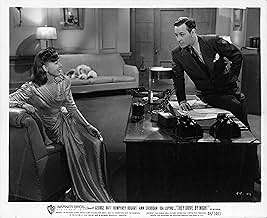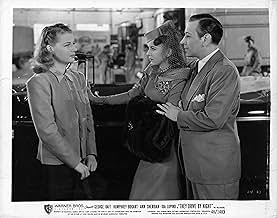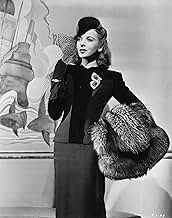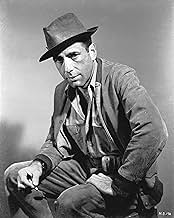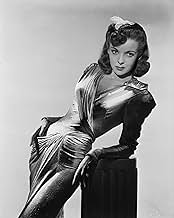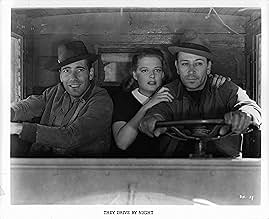Adicionar um enredo no seu idiomaWhen one of two truck-driving brothers loses an arm, they both join a transport company where the other is falsely charged as an accessory in the murder of the owner.When one of two truck-driving brothers loses an arm, they both join a transport company where the other is falsely charged as an accessory in the murder of the owner.When one of two truck-driving brothers loses an arm, they both join a transport company where the other is falsely charged as an accessory in the murder of the owner.
- Direção
- Roteiristas
- Artistas
- Prêmios
- 2 vitórias no total
Eddie Acuff
- Driver in Café
- (não creditado)
William Bendix
- Truck Driver Watching Pinball Game
- (não creditado)
Marie Blake
- Waitress
- (não creditado)
Chet Brandenburg
- Man Griping at Farnsworth
- (não creditado)
Eddy Chandler
- Driver
- (não creditado)
Richard Clayton
- Young Man
- (não creditado)
Joyce Compton
- Sue Carter
- (não creditado)
Alan Davis
- Driver
- (não creditado)
Joe Devlin
- Fatso
- (não creditado)
- Direção
- Roteiristas
- Elenco e equipe completos
- Produção, bilheteria e muito mais no IMDbPro
Avaliações em destaque
With a cast of Humphrey Bogart, George Raft, Ida Lupino and Ann Sheridan, it would virtually be impossible to make a mediocre film. And this is not mediocre. The plot of this film has several complications, which enrich the enjoyment of the movie. There are both dramatic and romantic surprises in the film. Enjoy these Golden Age performances by some of the best in the business. Good family fare.
Truck-driving brothers GEORGE RAFT and HUMPHREY BOGART not only have to put up with the hazards of wildcat driving but the manipulations of the scheming wife of boss ALAN HALE, played with intense conviction by IDA LUPINO.
But it's a plodding tale that takes awhile to work up any steam while director Raoul Walsh concentrates on the rough-housing camaraderie of the blue collar set before getting to the heart of the story involving two very different women--the good one, ANN SHERIDAN, and the femme fatale played with relish by IDA LUPINO. It is the romantic trio that ends in tragedy that gives the film its potent interest.
Lupino's mad scene on the stand is worth waiting for--although not entirely convincing. Nevertheless, she creates a vixen you won't soon forget.
George Raft ambles pleasantly through a rather dull role while Humphrey Bogart, as his brother, attracts more attention in a sideline role. Ann Sheridan is a sheer delight, adding her usual warmth and zest to a typical Sheridan role. The script crackles with tart remarks.
Not exactly great filmmaking--and too long in getting started--but worth the wait for some good performances. Only drawback seemed to be ALAN HALE as an oafish boss who becomes even more obnoxious when he's drunk. Hale overplays the role to such a degree that, in a way, it comes as a relief to see Ida knock him off with those car doors. "The doors made me do it!" is her scream from the witness stand.
Summing up: the kind of melodrama Warner was famous for in the '40s with the right cast doing it justice.
But it's a plodding tale that takes awhile to work up any steam while director Raoul Walsh concentrates on the rough-housing camaraderie of the blue collar set before getting to the heart of the story involving two very different women--the good one, ANN SHERIDAN, and the femme fatale played with relish by IDA LUPINO. It is the romantic trio that ends in tragedy that gives the film its potent interest.
Lupino's mad scene on the stand is worth waiting for--although not entirely convincing. Nevertheless, she creates a vixen you won't soon forget.
George Raft ambles pleasantly through a rather dull role while Humphrey Bogart, as his brother, attracts more attention in a sideline role. Ann Sheridan is a sheer delight, adding her usual warmth and zest to a typical Sheridan role. The script crackles with tart remarks.
Not exactly great filmmaking--and too long in getting started--but worth the wait for some good performances. Only drawback seemed to be ALAN HALE as an oafish boss who becomes even more obnoxious when he's drunk. Hale overplays the role to such a degree that, in a way, it comes as a relief to see Ida knock him off with those car doors. "The doors made me do it!" is her scream from the witness stand.
Summing up: the kind of melodrama Warner was famous for in the '40s with the right cast doing it justice.
If you could distil the essence of the actors in this quite ordinary film and add to it the forfeit George Raft paid for his poor future choices, the oyster and the world would be yours.
I get more respect for director Raoul Walsh with every film of his I see. In this one for Warner Brothers he does an excellent job with a strong cast telling a story about California Long Haul Truckers in the late 1930's. The realism is there all the way through.
This is one of George Rafts better performances, and Ida Lupino is excellent as the woman he scorns. Ann Sheridan is very good as the woman he loves. Humphrey Bogart in a supporting role is very good as Rafts brother. Alan Hale Sr. does a fine job as Lupinos husband.
The film gives the viewer a very strong flavor for what the early long haul trucking was like before World War 2. With the roads the way they were in that era, Long Haul in this is shorter than today & trucks were really just getting started, the railroads still dominated freight then in the US.
The story while more predictable than Dark Command which Walsh had just finished, still does a good job of pulling in the viewer with Raft & Bogarts characters flying on the edge of failure early in the film. The accident sequences are done crudely but this was in a day when the special effects were still developing. The main action in this film is truck accidents & a couple of fist fights.
This is a very fundamentally sound film as Raol Walsh always seems to deliver. In this case, the truckers deliver a good story.
This is one of George Rafts better performances, and Ida Lupino is excellent as the woman he scorns. Ann Sheridan is very good as the woman he loves. Humphrey Bogart in a supporting role is very good as Rafts brother. Alan Hale Sr. does a fine job as Lupinos husband.
The film gives the viewer a very strong flavor for what the early long haul trucking was like before World War 2. With the roads the way they were in that era, Long Haul in this is shorter than today & trucks were really just getting started, the railroads still dominated freight then in the US.
The story while more predictable than Dark Command which Walsh had just finished, still does a good job of pulling in the viewer with Raft & Bogarts characters flying on the edge of failure early in the film. The accident sequences are done crudely but this was in a day when the special effects were still developing. The main action in this film is truck accidents & a couple of fist fights.
This is a very fundamentally sound film as Raol Walsh always seems to deliver. In this case, the truckers deliver a good story.
This is the kind of movie that makes movie buffs movie buffs. On the surface the story is routine (I'm tempted to say hackneyed), the psychology shallow, the acting variable, and the meaning, such as it can be said to have one, borderline moronic. Yet it works like a charm, and is a minor classic of its kind. This is a tough movie to categorize. Not that one has to. It's a long haul trucker movie. But is that a genre? It has comedy and romance but is neither a comedy nor a romance; and it has tragedy but is not a tragedy. Near the end it turns into a murder story, though I wouldn't call it a crime picture. Director Raoul Walsh had a flair for subverting genres anyway, and made basically Raoul Walsh pictures, whatever the putative genre, and this one's about as Raoul Walsh as you can get.
It's the story of two brothers, played by George Raft and Humphrey Bogart, who are wildcat truckers who don't want to work for anyone else. They'd like to own their own rig but can't afford one, and are in debt up to their ears half the time. As the story progresses, Bogart loses in arm in an accident, and the boys have to go work for the boorish if amiable Alan Hale, whose wife, Ida Lupino, has eyes for Raft. Ann Sheridan is also on hand, as the hash-slinging good girl Raft really belongs with. Nothing special here, no great drama, and certainly no surprises. What drives the film, literally, is its optimism, especially as it relates to "little guys" Raft and Bogart. Without being too emphatic about it the movie is like a cheerleader for these two from start to finish.
The dialogue is salty and well-delivered by all, even the usually tedious Raft, while the background stuff,--the diners, rented rooms and garages--is beautifully detailed and always believable. Director Walsh was made for Warner Brothers, the studio that produced the film. He had a feeling for regular people, informal surroundings, the hustle and bustle of working life. Nor was he the least bit pretentious. The studio's famous liberalism didn't seem to rub off on him. He remained a populist with an anarchic streak, and was never an ideologue, hence this movie's depiction of blue collar life rings truer than most, as we know that these little guys want to be big shots (as most little guys do), and that they mean it when they say they want to give everyone a fair shake. We know in our guts that if these two ever make it to the big time they'll be awfully nice guys to work for. It's not easy for a movie to convince a viewer of such things,--it's not easy for a movie to be convincing at all, but this one is. Thanks to Raoul Walsh, with a little help from his fine cast.
It's the story of two brothers, played by George Raft and Humphrey Bogart, who are wildcat truckers who don't want to work for anyone else. They'd like to own their own rig but can't afford one, and are in debt up to their ears half the time. As the story progresses, Bogart loses in arm in an accident, and the boys have to go work for the boorish if amiable Alan Hale, whose wife, Ida Lupino, has eyes for Raft. Ann Sheridan is also on hand, as the hash-slinging good girl Raft really belongs with. Nothing special here, no great drama, and certainly no surprises. What drives the film, literally, is its optimism, especially as it relates to "little guys" Raft and Bogart. Without being too emphatic about it the movie is like a cheerleader for these two from start to finish.
The dialogue is salty and well-delivered by all, even the usually tedious Raft, while the background stuff,--the diners, rented rooms and garages--is beautifully detailed and always believable. Director Walsh was made for Warner Brothers, the studio that produced the film. He had a feeling for regular people, informal surroundings, the hustle and bustle of working life. Nor was he the least bit pretentious. The studio's famous liberalism didn't seem to rub off on him. He remained a populist with an anarchic streak, and was never an ideologue, hence this movie's depiction of blue collar life rings truer than most, as we know that these little guys want to be big shots (as most little guys do), and that they mean it when they say they want to give everyone a fair shake. We know in our guts that if these two ever make it to the big time they'll be awfully nice guys to work for. It's not easy for a movie to convince a viewer of such things,--it's not easy for a movie to be convincing at all, but this one is. Thanks to Raoul Walsh, with a little help from his fine cast.
Você sabia?
- CuriosidadesThe wife of producer Mark Hellinger, Gladys Glad, a former showgirl for Broadway producer Florenz Ziegfeld Jr., was responsible for getting this film made. Hellinger had brought home a large stack of scripts that he was to read for filming consideration. He had leafed through the script and read the summary, but felt that "nobody would pay money to see a bunch of truck drivers." His wife read this script, liked it, and pressured Hellinger to read it. Reluctantly, he did, the film eventually got made, and it became the sleeper hit of the year for Warners. It was made for an estimated $400,000 and grossed more than $4 million. (Source: Book "The Mark Hellinger Story" by Jim Bishop, New York: Appleton-Century-Crofts, 1952)
- Erros de gravaçãoWhen Joe and Paul's truck crashes, a motorist in a 1933 Cadillac with California license number 2N 214 stops to give assistance. Later, at Ed and Lana Carlson's anniversary party the same car (and same license number) is shown as one of Ed's cars as he demonstrates his garage door opener.
- Citações
Ed Carlsen: Early to rise and early to bed, makes a man healthy, but socially dead!
- ConexõesFeatured in Hollywood: The Great Stars (1963)
- Trilhas sonorasWhen the Swallows Come Back to Capistrano
(1940) (uncredited)
Music by Leon René
Played at Mandel's Cafe
Principais escolhas
Faça login para avaliar e ver a lista de recomendações personalizadas
- How long is They Drive by Night?Fornecido pela Alexa
Detalhes
- Data de lançamento
- País de origem
- Central de atendimento oficial
- Idiomas
- Também conhecido como
- They Drive by Night
- Locações de filme
- Empresa de produção
- Consulte mais créditos da empresa na IMDbPro
Bilheteria
- Orçamento
- US$ 400.000 (estimativa)
- Tempo de duração1 hora 35 minutos
- Cor
- Proporção
- 1.33 : 1
Contribua para esta página
Sugerir uma alteração ou adicionar conteúdo ausente


